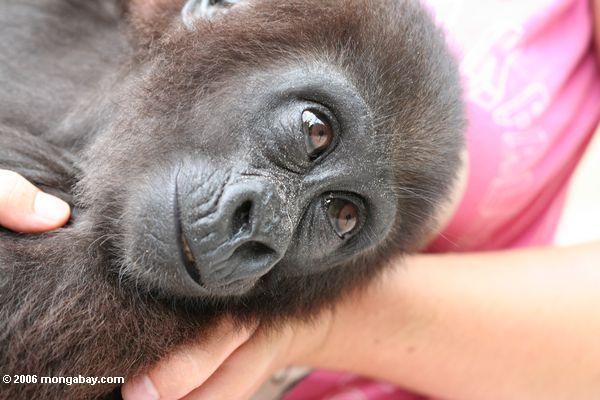For those living either north or south of the tropics, images of this green ring around the Earth’s equator often include verdant rainforests, exotic animals, and unchanging weather; but they may also be of entrenched poverty, unstable governments, and appalling environmental destruction. A massive new report, The State of the Tropics, however, finds that the truth is far more complicated—and much more interesting.
Starting with Aristotle’s misguided belief that no civilization could thrive in the tropics, the region—which covers around 40 percent of the world’s surface—has long been defined by views from the outside. But, according to the report’s co-author Sandra Harding, that must change.
“At a time of increasing concern about social, environmental and economic sustainability, a different approach is long overdue,” writes Harding, Vice-Chancellor and President of James Cook University. “It is time to recognize and acknowledge the tropics as a region defined from within, rather than without, to embrace the wisdom and experience of its peoples.”
Compiled by 12 institutions, the 400-plus page report attempts to explore the full region of the tropics, including demographics, health, science, economics, biodiversity, and climate change, among other issues. It finds that major changes are afoot in the region, including incredible population growth, rising economic importance, clashes over land-use, imperiled biodiversity, and worsening impacts of climate change.
Population explosion
Currently, the tropics are home to about 40 percent of the world’s population, but house the majority (55 percent) of children under five. Populations in the tropics—especially Africa—are growing at a much faster clip than in temperate regions. In fact, within 40 years, it is expected that more than half the world’s population will be in the tropics and a staggering 67 percent of its young children. According to the report, the region is expected to add another 3 billion people (or 42 percent of the world’s population today) by the end of the century.
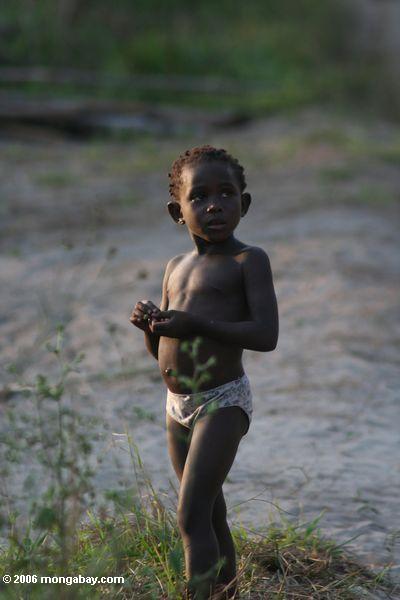 Child in Gabon. The tropics are increasingly becoming the epicenter of the human population, already the region is the epicenter of population growth. Photo by: Rhett A. Butler. |
“Because most of the world’s children will live in the Tropics by 2050, we must rethink the world’s priorities on aid, development, research and education,” Harding said. For example, it is estimated that around 467 million people in the tropics lived in slums as of 2001, representing 46 percent of the region’s urban population.
A booming population also means increased demand for food, water, and other natural resources internally, even while many of these resources are already exported abroad to temperate regions. Meanwhile, tropical economies are growing 20 percent more rapidly than in temperate region, yet the tropics is still home to two-thirds of the world’s population living in extreme poverty.
While extreme poverty has fallen in Southeast Asia and Central America, it has doubled in Central and Southern Africa since the early 1980s. Not everything, though, is gloomy.
“The prevalence of undernourishment in the tropics has declined by one-third over the past two decades,” reads the report, adding that “outcomes are improving rapidly for the majority of health indicators and for the majority of regions in the tropics.”
Life expectancy is on the rise in the tropics, while maternal and child mortality has been slashed in a matter of decades. Such changes could, in the long-term, also slow down population growth, since when women are ensured their children will survive they are less likely to have large families. Still, the region has not caught up to statistics in the temperate regions. Moreover, people in the tropics face especially challenging diseases rarely found in temperate regions such as dengue fever and malaria, which remains the biggest killer in many tropical countries.
Battles for land and the environment

Unbroken rainforest in Borneo. Rainforest destruction in Indonesia and Malaysia are now some of the highest in the world. Photo by: Rhett A. Butler.
Growing populations—along with consumption—has led to new political and social problems, including increasing clashes over land-use. Local people and indigenous groups are struggling to maintain control over their traditional lands as corporations—often foreign—seek out more land to grow crops, raise livestock, or extract commodities such as timber, fossil fuels, and minerals. Land-grabbing, as it is known, has become a significant political issue in places like Papua New Guinea, Cambodia, Kenya, and Cameroon.
At the same time, conservationists and environmentalists are fighting to preserve rainforests, coral reefs, and other vital ecosystems from destruction.
“The [tropics] hosts approximately 80 percent of [the Earth’s] terrestrial biodiversity and more than 95 percent of its mangrove and coral reef-based biodiversity,” reads the report.
In fact, the tropics—both on land and in the sea—are well-known as the world’s richest latitudes for species. For example, a single hectare in Yasuni National Park in Ecuador, which is imperiled by oil drilling, contains more tree species than are found in the entireties of U.S. and Canada combined. So, if the world is to preserve its biological wealth—and escape mass extinction—it must first safeguard ecosystems in the tropics.

Rice paddies in Laos. Photo by: Rhett A. Butler.
“The extent of primary forests in the Tropics is decreasing rapidly with associated increased risks to biodiversity. Rates of loss have seemingly slowed since the year 2000 in Central America, South America, Southeast Asia and Northern Africa & Middle East. However, they have increased in Oceania,” reads the report. “Furthermore, and disconcertingly, technological advances based on improvements in remote sensing suggest that losses may be under reported in some regions.”
Underlining these various trends, new research using high resolution satellite images has discovered that Indonesia has eclipsed Brazil in forest destruction for the first time. While Brazil has successfully curtailed—if not eliminated—deforestation over the last decade, forest destruction has only escalated rapidly in Indonesia largely for oil palm plantations, pulp and paper, and logging. This despite a much-ballyhooed moratorium on new logging and monoculture plantations.
On the plus side, tropical countries have set aside a higher percentage of their land as protected areas than temperate regions, yet parks in the tropics generally face more problems. Many are underfunded and understaffed. Illegal deforestation and poaching are so rampant in some tropical protected areas that conservationists have dubbed them “paper parks”— i.e., parks in name only. Another threat is that many tropical governments are opening up portions of their parks—or even entire protected areas— for logging, mining, agriculture, fossil fuel exploitation, and roads.
Into the oceans
The tropic’s marine resources are also facing unprecedented pressures. As with the tropics’ rainforests, the oceans in the region sport the world’s most species-rich ecosystems: coral reefs. Moreover, the tropics are home to the bulk of the world’s mangroves.
“Oceans comprise 76 percent of the tropics,” reads the report. “They are generally shallower and warmer than in other parts of the world, and also tend to be lower in nutrients hence support lower densities of marine organisms. However, although lower in overall fish biomass the tropics’ share of the overall global wild marine fish catch is increasing.”
But overfishing and destructive fishing practices has already depleted some species in parts of the tropics.
“Human population growth, particularly in tropical coastal communities, and increasing affluence, is forecast to further increase
pressures on marine fish stocks,” reads the report. Other threats include pollution, coastal development, plastic waste, fossil fuel exploitation, and, on the horizon, deep sea mining.
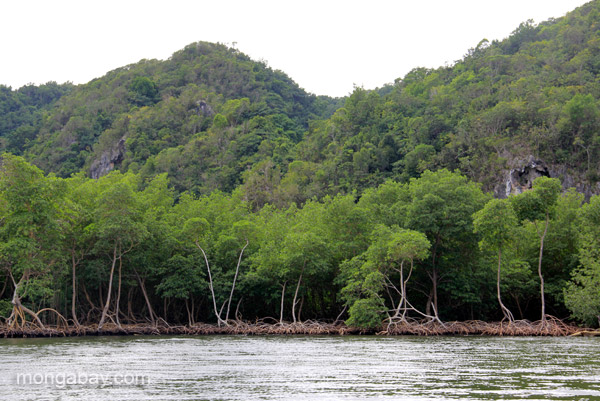
Mangroves in the forefront with karst hills in background in the Dominican Republic’s Los Haitises National Park. Photo by: Jeremy Hance.
Mangroves, one of the region’s most important marine ecosystems, are under siege. Although mangroves buffer coastal communities from tropical storms, provide important fish nurseries, and store vast amounts of carbon, these marine forests are being rapidly destroyed for aquaculture and development. Between 1990 and 2005, the world lost 19 to 35 percent of its mangroves.
“Mangroves are one of the more threatened ecosystems in the world,” reads the report.
Meanwhile, rising threats such as climate change and ocean acidification could lead to the ecological collapse of some systems and even mass extinction. For example, currently more than half the coral reefs in the region are listed as medium or high risk.
Into the future
One of the major challenges in the tropics is preserving biodiversity in midst of growing human populations and greater demands for natural resources and land. Photo by: Rhett A. Butler.
As with the rest of the world, climate change poses one of the biggest challenges to the tropics in the coming decades. More extreme weather, rising seas, changing precipitation patterns, and agriculture fallout could all imperil tropical communities. Experts fear that such upheavals could also increase the number of refugees and regional conflict.
Yet, climate change is also expanding the tropics into the once-temperate zones. According to the report, the tropics are marching north and south at the rate of about 38-277 kilometers every 25 years.
“Subtropical arid conditions may eventually be experienced in regions at higher latitudes which have historically enjoyed a more temperate climate…This has implications for management of water resources and agricultural systems,” said report co-author Jo Isaac. “However, some regions which currently border the equatorial zone may experience an increase in extreme rainfall, which could result in flooding, the displacement of communities and increased incidence of disease.”
Overall, the future of the tropics is one of rising influence and wealth, but also of struggles to eliminate poverty and hunger, improve health standards, preserve biodiversity, mitigate climate change, and safeguard resources for future generations.
“We began this project to try to reframe how people see the world—the report confirms the great potential that the tropics hold—arguably the future does belong to the tropics,” Harding noted.
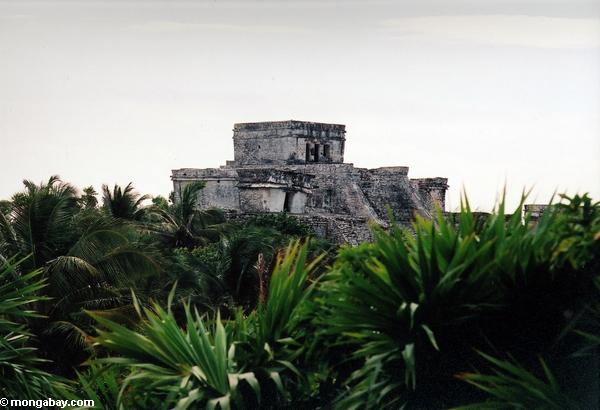
Humans first evolved in tropical Africa before marching into the temperate zones. Since then many of the world’s most important civilizations rose and fell in the tropics, such as the Mayans of North and Central America. Photo by: Rhett A. Butler.
Related articles
Oil, wildlife, and people: competing visions of development collide in Virunga National Park

(07/07/2014) What does SOCO’s withdrawal really mean for the future of Virunga National Park? – Part II. Located in the eastern DRC, Virunga is the first national park created in Africa, a World Heritage Site and home to mountain gorillas, of which fewer than 900 remain. As such, SOCO’s announcement to suspend activities followed in the wake of a concerted campaign led by WWF to “draw the line” to save Virunga from devastation by prospective oil drilling.
Despite moratorium, Indonesia now has world’s highest deforestation rate

(06/29/2014) Despite a high-level pledge to combat deforestation and a nationwide moratorium on new logging and plantation concessions, deforestation has continued to rise in Indonesia, according to a new study published in Nature Climate Change. Annual forest loss in the southeast Asian nation is now the highest in the world, exceeding even Brazil.
Ecotopia emerging: sustainable forests and healthy livelihoods go hand in hand

(06/26/2014) Callenbach’s 1975 utopian novel Ecotopia became wildly popular among environmental-leaning folks, hippies, and progressive thinkers of the day. Set in 1999, the novel took place twenty years after Oregon, Washington and northern California seceded from the union to form an imperfect, in-process sustainable nation. For a book that has fallen mostly off the radar, certain aspects of Ecotopian society fall remarkably in line with research of Arun Agrawal, a professor of political science at the University of Michigan.
Unrelenting population growth driving global warming, mass extinction

(06/26/2014) It took humans around 200,000 years to reach a global population of one billion. But, in two hundred years we’ve septupled that. In fact, over the last 40 years we’ve added an extra billion approximately every dozen years. And the United Nations predicts we’ll add another four billion—for a total of 11 billion—by century’s end.
APP: Indonesia needs a new business model

(07/04/2014) In response to news that Indonesia has now surpassed Brazil as the world’s top deforester, the head of sustainability at one of Indonesia’s biggest forestry companies is calling for a new business model in how the Southeast Asian nation manages its forest. In a letter published Friday, Aida Greenbury, Asia Pulp & Paper’s Managing Director Sustainability, said Indonesia needs to take a more comprehensive approach to tackling deforestation.
Do Indonesians really want more big plantations?
(07/04/2014) How to best use Indonesia’s land resources? This is one of the more crucial questions facing the Presidential candidates in Indonesia’s upcoming elections.
A fine line: new program predicts when human impact becomes too much

(07/03/2014) Scientists at Stanford University recently unveiled a new modeling program that can predict the response of the environment to the land-use changes of human communities. Using their model, they found that natural resources can support humanity – up to a certain point.
Next big idea in forest conservation? The ‘double-edged sword’ of democracy

(07/03/2014) Dr. Douglas Sheil considers himself an ecologist, but his research includes both conservation and management of tropical forests. Currently teaching at the Norwegian University of Life Sciences (NMBU) Sheil has authored and co-authored over 200 publications including scholarly articles, books, and popular articles on the subject.
A children’s book inspired by murder: the 25th anniversary of ‘The Great Kapok Tree’

(07/03/2014) “The Great Kapok Tree” was written by Lynne Cherry in response to the murder of Brazilian environmental activist Chico Mendes, who was assassinated by a rancher in 1988 in Brazil. Mendes’ murder was a significant international incident galvanizing support for environmental activists working to protect the Amazon forest.
On a whim: Equatorial Guinea building new capital city in the middle of the rainforest
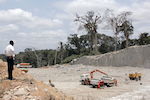
(07/02/2014) More than 8,000 hectares of rainforest are under threat as the nation builds a new $600 million capital city from scratch. Called Oyala, and also known as Djibloho, the city is expected be completed by 2020 and house up to 200,000 people — about an eighth of the entire population of Equatorial Guinea.
On the brink of extinction: Javan rhino has new enemy in invasive palm

(07/01/2014) The last of Indonesia’s critically endangered Javan rhinoceroses have survived poachers, rapid deforestation and life in the shadow of one of the archipelago’s most active volcanoes. But an invasive plant is now posing a new threat to the world’s rarest species of rhino.
On babies and motherhood: how giant armadillos are surprising scientists (photos)
.150.jpg)
(07/01/2014) Until ten years ago scientist’s knowledge of the reproductive habits of the giant armadillo— the world’s biggest— were basically regulated to speculation. But a long-term research project in the Brazilian Pantanal is changing that: last year researchers announced the first ever photos of a baby giant armadillo and have since recorded a second birth from another female.
Oil palm plantations degrade local water quality relative to community forests
(06/30/2014) Oil palm plantations are not only encroaching on forests, they are also degrading water quality, finds a new study published in the Journal of Geophysical Research: Biogeosciences.
Malaysian citizens want govt to spend more to save native rainforests
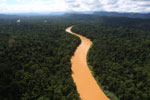
(06/30/2014) As developing countries reach upper middle income (UMI) status, their populations are willing to pay increasing amounts toward tropical forest conservation, yet government spending on these programs lags far behind, concludes a study available today in the PNAS Online Early Edition.
